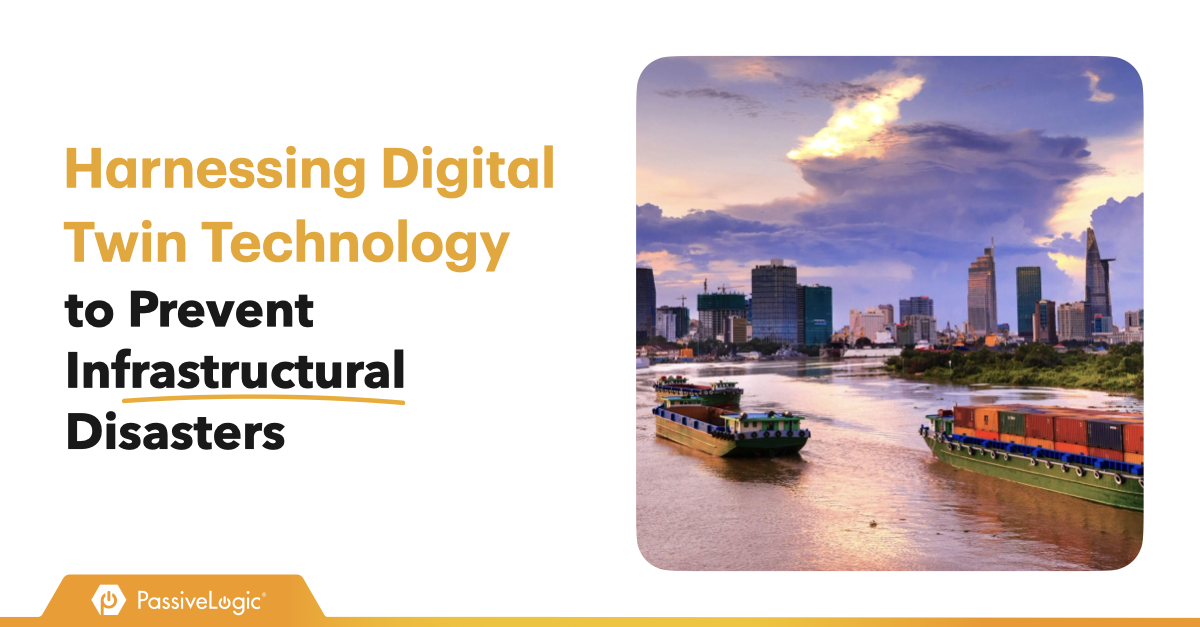
Harnessing Digital Twin Technology to Prevent Infrastructural Disasters

Harnessing Digital Twin Technology to Prevent Infrastructural Disasters
While the idea of digital twins has been around for a while, their definition remains inconsistent. A digital twin is most commonly understood as a visually accurate, virtual copy of a real-world object. The closest analogous technology in our industry is Building Information Modeling, or BIM, in the cloud. BIM captures accurate geometric data and spatial information regarding a building and its systems in a visualizable virtual 3D model that can also be queryable. You can click around a model, see key information, and pull that information into other sources.
Knowing the geometry of a building is important, but it represents only a small portion of the information true digital twins encapsulate. At PassiveLogic, a digital twin goes beyond this basic understanding, and becomes a model that understands what it is, its purpose, and how its components work together in an ontology. True digital twins offer a much deeper level of understanding about buildings, well beyond simple spatial models. To really dive into how PassiveLogic qualifies a digital twin, watch our 2023 Launch Event and check out this blog post.
True digital twins have the power to revolutionize disaster prevention strategies for large infrastructure, whether from natural causes or operational technology (OT) failures. It’s becoming more common to hear about aging and collapsing buildings, many of which were designed to only last between 50-100 years. Considering humans spend the vast majority of our lives inside buildings—up to 90% of our time—and urbanization is only increasing, this is an issue that indiscriminately affects all of us. The recent building collapses in Syria and Turkey, where over 160,000 buildings in Turkey alone were either destroyed or severely damaged are a relevant example of a tragic and potentially avoidable event. Another example is the cargo ship crash in Baltimore, Maryland. These massive ships are essentially floating buildings. Experts have been discussing how digital twin technology may have prevented or mitigated the accident, which was due to failures of the ship’s industrial control systems (ICS) and/or OT. The structure of the ship was sound, but the massive robotic systems controlling it failed.
Like a cargo ship, a building’s structural and operational resilience is critical. The internal mechanical robotics controlling a structure need attention as well as the body. Failure to maintain the internal and external systems of these massive robots yields devastating, widespread impact. So, how do we continuously and accurately calculate the intricate physics, monitor tons of sensor data, and manage the complicated outputs required to do this at scale in buildings and beyond?
Digital twin technology powered by generative AI allows us to not only design better infrastructure, but also safely and efficiently operate, predictably maintain, and manage even the largest structures throughout their entire lifecycle.
Below, we explore how digital twins are reshaping infrastructural disaster prevention efforts, with an initial focus on buildings.
Understanding Digital Twins
True digital twins are virtual representations of physical entities or systems, continuously updated with data from sensors, IoT devices, and other sources. These dynamic replicas accurately reflect the behavior and characteristics of their real-world counterparts, enabling sophisticated analysis, simulation, and optimization. By integrating advanced analytics and simulation techniques, digital twins offer invaluable insights into building performance, vulnerabilities, and disaster risks
Preventing Building Disasters
Buildings are susceptible to a myriad of disasters, ranging from structural failures and fires to natural hazards like earthquakes and hurricanes. This is especially relevant now as climate change increases the frequency and severity of these events. Buildings are also the world’s largest and most ubiquitous robots—with the largest buildings trending toward one million input and output sensors and controllables—making them highly susceptible to ICS and OT failures. Digital twin technology empowers stakeholders, from architects and engineers to facility managers and emergency responders, with tools to proactively prevent disasters and mitigate risks.
Through detailed modeling and simulation, digital twins can assess structural integrity, predict potential failures, and optimize building designs for resilience. Real-time autonomous monitoring of environmental conditions, occupancy patterns, and safety systems allows for early detection of anomalies and swift intervention in emergency situations
Enhancing Structural Resilience
The structural integrity of buildings is paramount in disaster prevention efforts. Digital twins facilitate detailed analysis of building materials, designs, and construction methods, enabling stakeholders to identify vulnerabilities and implement targeted interventions. By simulating various stress scenarios, such as seismic activity or extreme weather events, digital twins help optimize structural designs, retrofit aging infrastructure, and ensure compliance with safety standards. Programs, such as Building Studio, utilize historical location-based data to provide high-speed analysis and simulate the effects of global positioning, sunlight, elevation, and surrounding structures. Continuous monitoring of structural health parameters enables early detection of degradation or damage, preventing catastrophic failures and safeguarding occupants.
Optimizing Building Management
Effective and continuous building management is essential for disaster prevention and response. Digital twins serve as comprehensive platforms for automated building performance monitoring, energy consumption, and occupancy dynamics. By integrating data from sensors, IoT devices, and building management systems—such as PassiveLogic’s Hive Autonomous Management System (AMS)—digital twins enable predictive maintenance, optimize resource allocation, and enhance emergency preparedness. They could even support real-time simulation of evacuation routes, fire spread patterns, and airflow dynamics supports proactive decision-making in emergency situations, ensuring the safety and well-being of occupants and first responders.
In an era defined by rapid urbanization, climate change, and technological advancement, the need to enhance building resilience and mitigate disaster risks is more pressing than ever. Digital twin technology emerges as a pivotal tool, offering unparalleled insights, predictive capabilities, and real-time monitoring for building infrastructure. By harnessing the potential of digital twins, stakeholders can proactively prevent disasters, safeguard lives, and better manage resources. As we continue to refine and integrate digital twin technology into building design and management practices, we move closer to a future where disasters are not just mitigated but prevented altogether, ensuring safer, more resilient communities for generations to come.